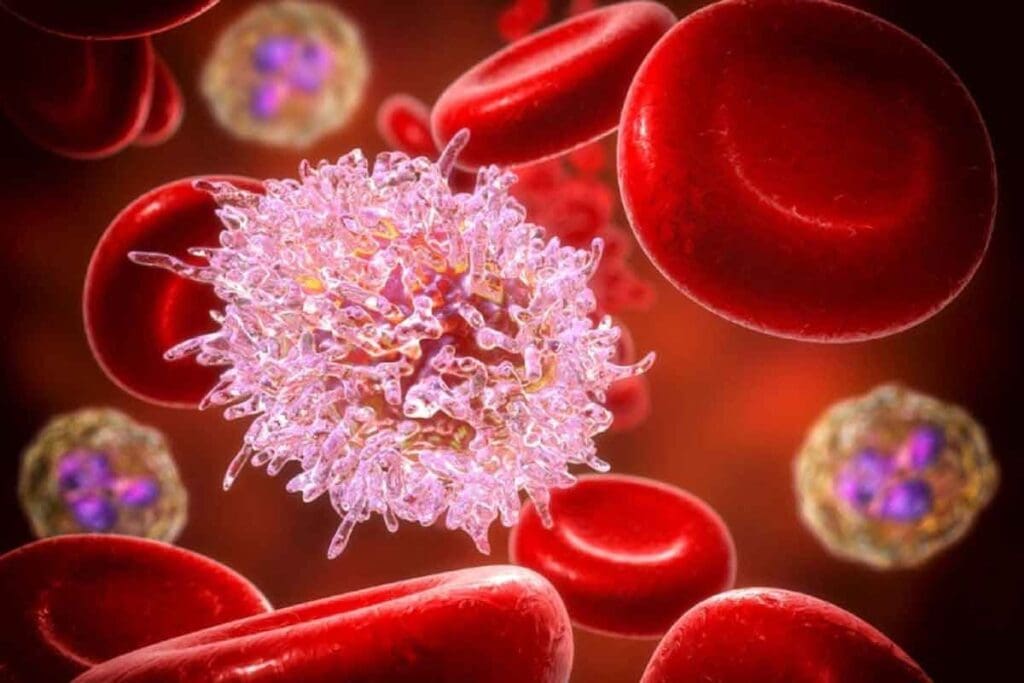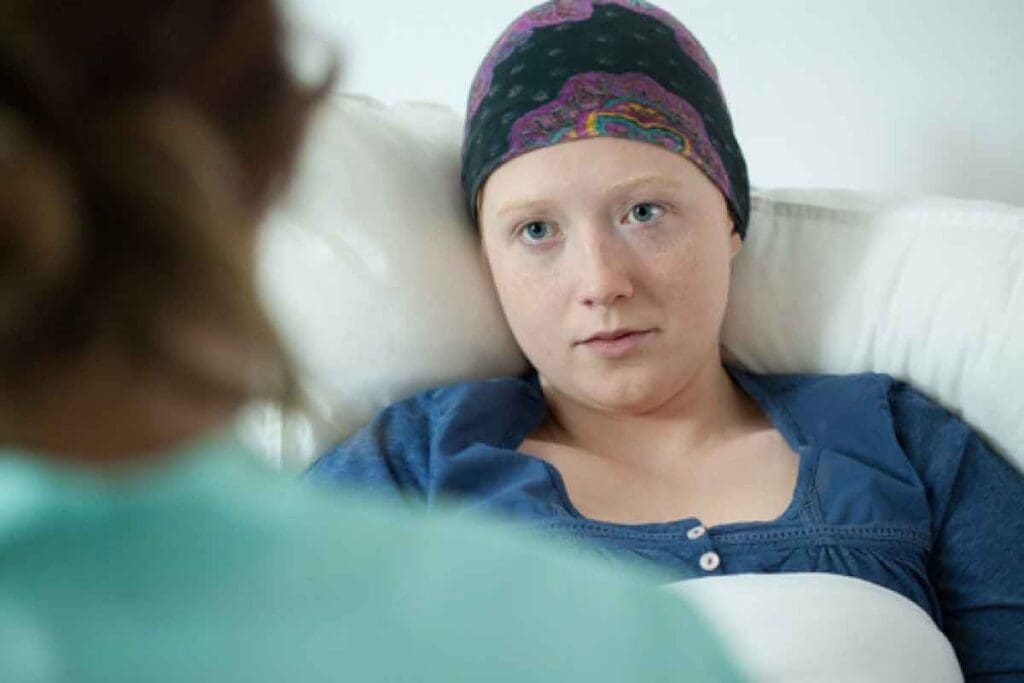Last Updated on November 18, 2025 by Ilayda Cengizhan

Leukemia is a type of cancer that affects the blood and bone marrow. It’s caused by the uncontrolled growth of abnormal white blood cells, which disrupt normal blood cell production. This condition impacts vital blood-forming tissues, such as the bone marrow and lymphatic system.
At Liv Hospital, we focus on providing advanced and compassionate care for patients diagnosed with leukemia. Our specialists help patients and families understand the key facts about leukemia, including its causes, symptoms, and treatment options.
By learning more facts about leukemia, patients can better understand their condition and make informed decisions about their treatment journey.
Understanding leukemia is key to effective diagnosis and treatment.

Leukemia is a cancer that affects the blood and bone marrow. It’s important to know about it. This disease impacts the body’s blood-making parts, like the bone marrow and lymphatic system. Learning about leukemia helps those affected manage and treat it better.
Leukemias start in the bone marrow. Here, abnormal white blood cells are made. These cells take over, making it hard for the body to fight off infections or deliver oxygen.
There are four main types of leukemia. These are Acute Lymphocytic Leukemia (ALL), Acute Myelogenous Leukemia (AML), Chronic Lymphocytic Leukemia (CLL), and Chronic Myelogenous Leukemia (CML). Each type has its own symptoms and treatment plans.
Acute Leukemias (ALL and AML) need quick treatment. Chronic Leukemias (CLL and CML) progress more slowly. Knowing the type helps choose the right treatment.

It’s important to know how leukemia affects public health in the US. This cancer impacts blood-forming tissues and has big effects on healthcare and people’s lives.
Leukemia is a big health worry. In 2025, there will be about 66,890 new cases and 23,540 deaths in the US. These numbers show how serious leukemia is.
Looking at leukemia’s numbers helps us see how big a problem it is. It shows us why we need more research and awareness.
The chance of getting leukemia is 1.5 percent for both men and women. This makes leukemia a big public health issue. Also, about 536,245 people in the US are living with leukemia now.
These numbers give us a clear picture of leukemia’s impact. They also show why we need to keep helping those with the disease. By understanding leukemia’s numbers, we can help patients more.
Diagnosing leukemia is tough because its symptoms are not clear, and there’s no good screening test. Unlike some cancers, there’s no standard test for leukemia. This makes it hard to catch it early.
We’ll look at why finding leukemia early is hard and what signs might mean you have it. Knowing these challenges helps us improve how we diagnose and treat it.
Screening for leukemia isn’t as easy as for other cancer,s like breast or colon cancer. For those, there are specific tests like mammograms and colonoscopies. But for leukemia, there’s no simple test to find it in people who don’t have symptoms. Doctors use a mix of physical checks, medical history, and lab tests like blood counts and bone marrow biopsies to diagnose it.
A leading cancer society says doctors usually diagnose leukemia after symptoms show up. This shows we need to know the symptoms of leukemia.
Leukemia symptoms can be vague and seem like common illnesses. But, there are signs that might mean you should see a doctor. These include:
Spotting these symptoms early and seeing a doctor can lead to a quicker diagnosis and better treatment. It’s key to know these signs and get medical help if they don’t go away or get worse.
In recent years, leukemia survival rates have greatly improved. This is thanks to new treatments. It shows how far medical research and treatments have come for patients.

The 5-year survival rate for leukemia patients has risen to about 67.8 percent. This shows how much progress has been made in early diagnosis and treatment. It gives patients a better chance of living longer.
Early detection and diagnosis are key to treating leukemia well. We stress the need for regular check-ups and screenings. This helps find the disease early.
New treatments like targeted therapies and CAR-T cell therapy are changing leukemia treatment. These therapies are more precise and effective. They improve patient outcomes and quality of life.
Targeted therapies target specific molecules in cancer cells, reducing harm to healthy cells. CAR-T cell therapy genetically modifies T cells to attack cancer cells. These advances offer new hope to patients and their families.
We are dedicated to advancing medical research and innovation. We aim to provide the best care and support to those with leukemia.
Age, gender, and ethnicity play big roles in who gets leukemia and what type. By looking at these patterns, we learn more about leukemia’s complex nature.
Age is a big factor in getting leukemia. Different types are more common at different ages. For example, acute lymphoblastic leukemia (ALL) often hits kids under 5. On the other hand, acute myeloid leukemia (AML) and chronic lymphocytic leukemia (CLL) are more common in older adults.
Leukemia happens differently in men and women, and in different ethnic groups. For instance, men are more likely to get leukemia than women. Some ethnic groups are more likely to get certain types of leukemia. A study found that CLL is more common in whites than in blacks, and rare in Asians.
‘The incidence of CLL is higher in whites than in blacks, and it’s relatively rare in Asian populations’
-As noted by specialists.
Leukemia is caused by both genetic and environmental factors. Knowing these factors helps us find who is at higher risk. It also helps us lower the chance of getting the disease.
Some environmental factors increase the risk of leukemia. Ionizing radiation is a big one. It comes from things like radiation therapy, some jobs, or nuclear accidents. Ionizing radiation can raise the risk of acute myeloid leukemia (AML).
Chemicals like benzene, found in gasoline and used in many industries, also raise the risk. Pesticides and herbicides used in farming or gardening can increase the risk, too. People working with these should follow safety rules closely.

Genetics also plays a big part in leukemia. Some genetic disorders, like Down syndrome, increase the risk. People with a family history of leukemia might also be at higher risk. Research has found certain genetic mutations that can lead to leukemia.
“The genetic component of leukemia is complex, involving multiple genes and possible environmental interactions. Further research is needed to fully understand the genetic underpinnings of this disease.”
Experts note.
Knowing about environmental and genetic factors helps us prevent and detect leukemia early. By finding who is at higher risk, doctors can offer better screening. This could help lower leukemia cases.
Leukemia patients can find comfort and guidance through various organizations. These groups are dedicated to providing leukemia support and resources. Living with leukemia means more than just medical treatment. It also involves emotional and informational support from trusted sources.
Many organizations play a key role in supporting patients. The Leukemia & Lymphoma Society offers a lot, like financial help, patient education, and advocacy. The American Society of Hematology also provides important information on the latest research and treatments.
Patients and their families can find many resources. These include support groups, educational materials, and online forums. These help people understand their condition better and cope with the diagnosis.
| Organization | Resources Offered | Contact Information |
| Leukemia & Lymphoma Society | Financial assistance, patient education, and advocacy | www.lls.org |
| American Society of Hematology | Latest research, treatment options, and professional directory | www.hematology.org |
By reaching out to these organizations, individuals affected by leukemia can get the support and information they need. This helps them navigate their journey more effectively.
We’ve looked at 12 interesting facts about leukemia, a complex blood cancer. Knowing about leukemia is key to early detection and treatment.
Our summary shows how important it is to recognize warning signs and understand the different types of leukemia. In the United States, leukemia has a big impact, with survival rates varying by age, demographics, and treatment.
By studying environmental and genetic factors, we can understand leukemia’s risk factors better. We’ve also talked about new treatments that are improving patient outcomes.
As we wrap up our look at leukemia, it’s clear that more research and awareness are needed. We hope this summary has given you valuable insights into leukemia.
For those with leukemia, we stress the need for support and resources. They help in facing the challenges of this diagnosis.
Leukemia is a cancer that affects the blood-making tissues. This includes bone marrow and the lymphatic system.
There are four main types of leukemia. These are Acute Lymphoblastic Leukemia (ALL), Acute Myeloid Leukemia (AML), Chronic Lymphocytic Leukemia (CLL), and Chronic Myeloid Leukemia (CML).
Symptoms of leukemia include feeling very tired, losing weight, and getting sick often. You might also bruise easily, bleed a lot, and have swollen lymph nodes.
Doctors use a few ways to diagnose leukemia. They do a physical check-up, ask about your health history, and run blood tests. They also do a bone marrow biopsy and imaging tests.
Certain things can increase your risk of getting leukemia. These include being exposed to harmful chemicals or radiation, having a family history, being older, and having certain health conditions.
There’s no guaranteed way to prevent leukemia. But avoiding harmful chemicals and radiation and staying healthy can help lower your risk.
Treatment for leukemia depends on the type and stage. Options include chemotherapy, targeted therapy, radiation therapy, and bone marrow transplantation.
The 5-year survival rate for leukemia has improved. This is thanks to new treatments. The survival rate varies based on the leukemia type.
Yes, many organizations offer help and support for leukemia patients and their families. They provide information and guidance.
Age is a big factor in leukemia risk. Some types are more common in older adults. Others are more common in children and young adults.
Leukemia affects different groups in different ways. Some groups have a higher risk of certain leukemia types.
Leukemia is a serious disease, but many people are cured with the right treatment. The cure rate depends on the leukemia type and stage.
Subscribe to our e-newsletter to stay informed about the latest innovations in the world of health and exclusive offers!